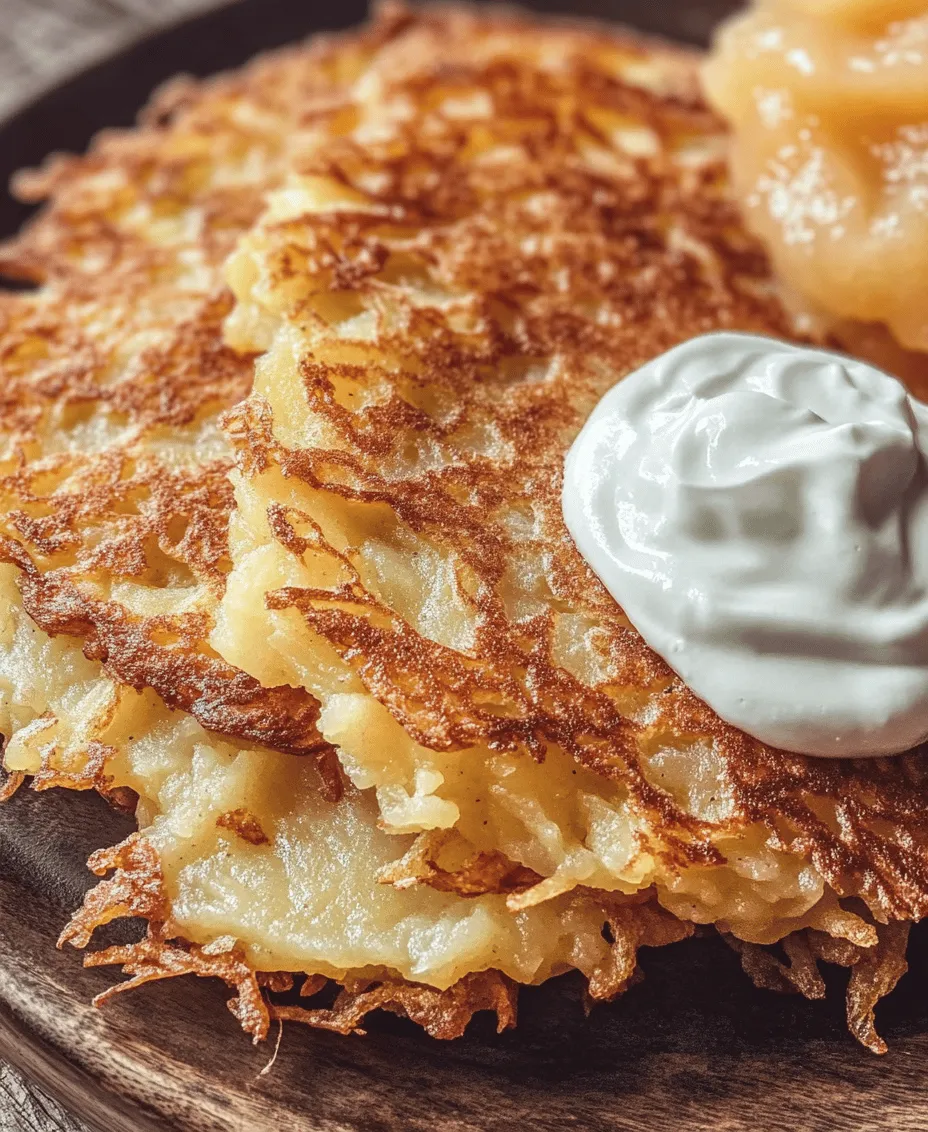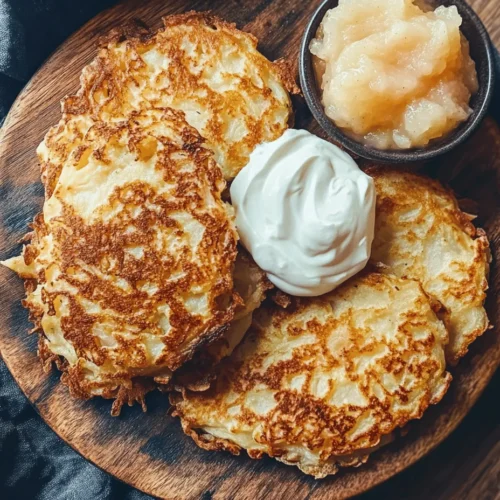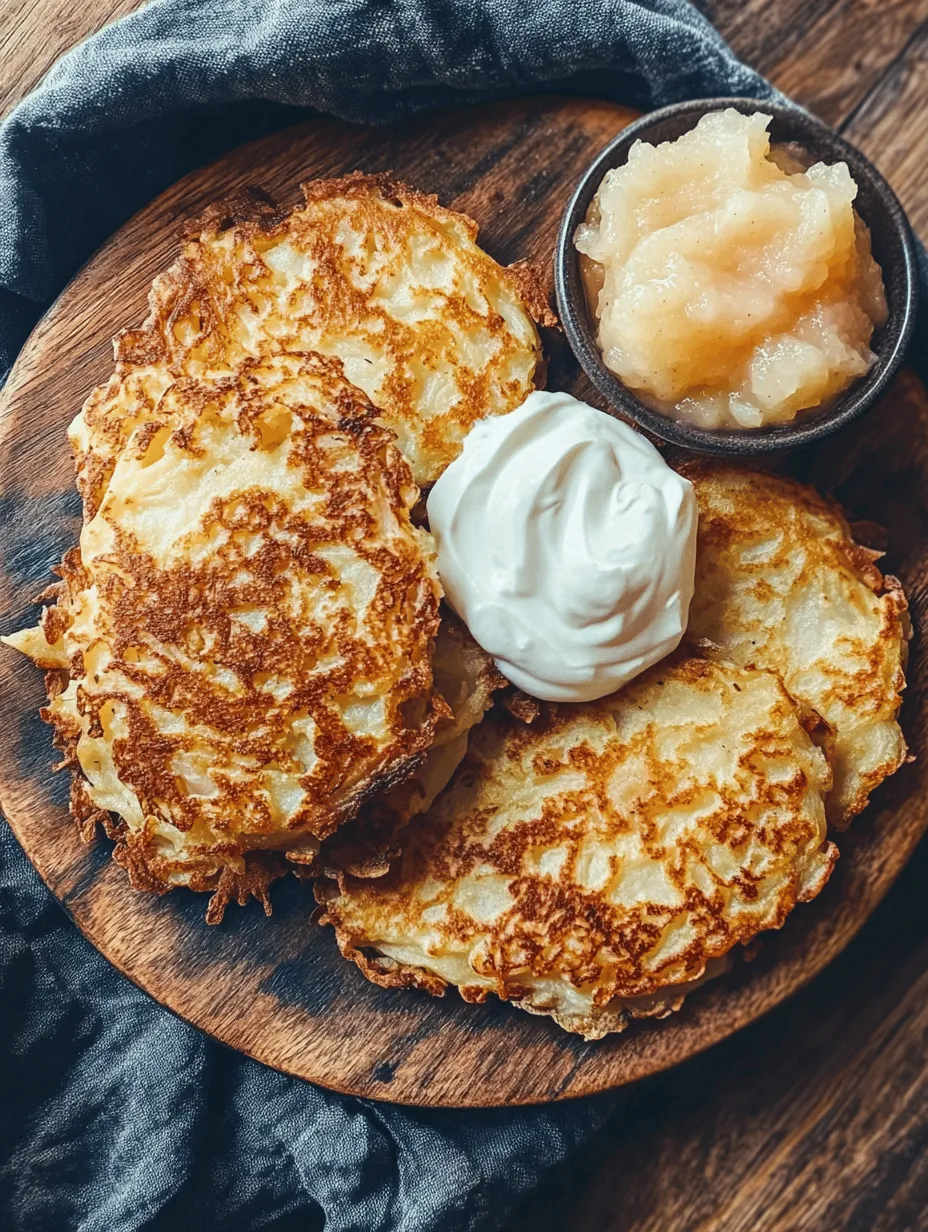Introduction
When it comes to traditional comfort food, few dishes can rival the warmth and familiarity of German potato pancakes, known as Reibekuchen. With their crispy edges and soft interiors, these delightful pancakes have captured the hearts and palates of people not just in Germany but around the world. A staple at festive markets and family gatherings, Reibekuchen are more than just a meal; they are a celebration of culinary heritage, often served with applesauce or sour cream, making them a versatile addition to any table.
The origins of German potato pancakes can be traced back to the country’s agrarian roots, where potatoes were a dietary staple. Over the years, variations of this dish have emerged, but the core elements remain the same: simple ingredients combined to create a dish that is both satisfying and delicious. Whether enjoyed for breakfast, lunch, or dinner, these pancakes resonate with a sense of nostalgia, reminding many of home-cooked meals shared with loved ones.
This article serves as an easy-to-follow guide for making authentic German potato pancakes right in your kitchen. With a few simple ingredients and straightforward steps, you can recreate this traditional dish and experience the delightful flavors that have made it a beloved classic.
Understanding the Ingredients
To achieve the perfect crunchy texture and rich flavor in your German potato pancakes, it’s essential to understand the role of each ingredient. Let’s break down the key components that contribute to this delectable dish.
Starchy Potatoes
At the heart of any good potato pancake is the potato itself. The choice of potatoes is crucial; starchy varieties, such as Russets or Yukon Golds, are ideal due to their high starch content. This characteristic helps create a light, fluffy interior while allowing for a crispy exterior when fried. Waxy potatoes, on the other hand, contain more moisture and can result in denser pancakes that lack the desired crunch. Therefore, selecting the right type of potato is the first step in perfecting your Reibekuchen.
Small Onion
Adding a small onion to your batter enhances the flavor profile of the pancakes. The onion contributes a subtle sweetness and depth, balancing the starchy potatoes. When finely grated, it integrates seamlessly into the mixture, ensuring that every bite is infused with its savory goodness. It’s essential to choose a fresh onion, as the quality of this ingredient can significantly impact the overall taste of your pancakes.
Egg and Flour
Eggs serve as a binding agent in the pancake mixture, ensuring that all the ingredients hold together during cooking. They also add richness to the dish. Flour plays a similar role by providing structure and stability. When using flour, it’s essential to strike a balance; too much can lead to heavy pancakes, while too little may result in them falling apart. A small amount is sufficient to achieve the desired consistency without overpowering the potato flavor.
Baking Powder
To achieve that perfect lightness, a pinch of baking powder is often included in the recipe. This leavening agent helps create air pockets within the batter, contributing to a fluffier texture. It’s a small addition that can make a big difference in the final product, ensuring your Reibekuchen are not just crispy but also tender on the inside.
Seasoning: Salt and Pepper
Seasoning is crucial for enhancing the flavors of your pancakes. A generous pinch of salt not only elevates the taste of the potatoes but also brings out the natural sweetness of the onion. Black pepper adds a subtle warmth that complements the other ingredients beautifully. Proper seasoning is essential to ensure that your Reibekuchen are flavorful and satisfying, so don’t shy away from tasting your mixture before frying.
Frying Oils
The choice of frying oil can dramatically impact the taste and texture of your potato pancakes. Traditional recipes often call for vegetable oil or sunflower oil due to their high smoke points, which are ideal for frying at high temperatures. These oils allow for a crispy exterior without burning. If you prefer a more robust flavor, you might consider using clarified butter or a combination of butter and oil, which can add richness to the pancakes. Regardless of the oil you choose, be sure to heat it adequately before adding the batter to achieve that coveted crunch.
Preparation Steps for Perfect Potato Pancakes
Now that we’ve covered the essential ingredients, let’s dive into the preparation steps necessary for crafting perfect German potato pancakes. These steps are designed to ensure that you achieve that ideal balance of crispy and tender in every bite.
Peeling and Soaking the Potatoes
The first step in making authentic Reibekuchen is peeling the potatoes. This process is essential, as the skin can contribute a bitter flavor and an undesirable texture to the pancakes. Once peeled, it’s important to soak the potatoes in water. This soaking step serves a dual purpose: it prevents oxidation, which can lead to discoloration, and it helps to remove excess starch, resulting in a lighter pancake.
Soak the peeled potatoes in cold water for about 15 to 30 minutes. This timeframe is sufficient to prevent browning while allowing the potatoes to retain their moisture. After soaking, drain the potatoes and pat them dry with a clean kitchen towel to remove excess water. This step is critical, as excess moisture can lead to soggy pancakes that fail to crisp up during frying.
Grating Techniques
Next, it’s time to grate the potatoes. You have a couple of options here: using a box grater or a food processor. Both methods can yield excellent results, but they do vary in texture. A box grater allows for a coarser texture, which can add a delightful bite to the pancakes. On the other hand, a food processor can achieve a finer grate, resulting in a smoother batter.
When grating, aim for consistency in size. Uniform shreds ensure that the pancakes cook evenly. Keep in mind that the coarseness of the grate will affect the final texture of the pancakes. Coarser shreds will create a chunkier bite, while finer shreds will yield a more delicate pancake.
Moisture Removal
Once the potatoes are grated, the next critical step is to remove excess moisture. This is vital for achieving that perfect crispy texture. Use a clean kitchen towel or cheesecloth to squeeze out as much liquid as possible from the grated potatoes. Gather the grated mixture in the center of the towel, twist it closed, and apply pressure to extract the liquid.
The moisture level in your batter directly influences the final product; too much moisture can lead to pancakes that are soft and soggy instead of crispy and golden. Aim to achieve a dry mixture that still holds together well when formed into patties.
Mixing the Batter
With the grated potatoes ready, it’s time to mix the batter. In a large mixing bowl, combine the grated potatoes, finely grated onion, egg, flour, baking powder, and the seasoned salt and pepper. It’s important to mix these ingredients gently, ensuring that everything is evenly distributed without overmixing. Overmixing can lead to gummy pancakes, so fold the ingredients together just until they are combined.
Once your batter is ready, it should be thick enough to hold its shape when spooned onto the frying pan but still have a slightly loose consistency. This balance is key to ensuring that your pancakes are both crispy on the outside and tender on the inside.
By following these preparation steps carefully, you’ll be on your way to creating deliciously crunchy authentic German potato pancakes that are sure to impress family and friends alike. In the next section, we will explore the frying process that brings these pancakes to life, ensuring they are golden brown and irresistibly crispy. Stay tuned for the continuation of this culinary journey!

Frying the Pancakes
Choosing the Right Skillet and Oil Temperature
When it comes to frying authentic German potato pancakes, the choice of skillet and the temperature of the oil are crucial for achieving that perfect, crispy texture. Ideally, you should use a heavy-bottomed skillet or cast-iron pan, as these distribute heat evenly and maintain the temperature during cooking. Non-stick pans can also work, but they may not provide the same level of browning.
Before you begin frying, it’s essential to heat the oil to the right temperature. A general rule of thumb is to preheat your skillet over medium to medium-high heat and add a generous amount of oil—about ¼ inch deep—preferably vegetable oil, canola oil, or even clarified butter for extra flavor.
To test if the oil is hot enough, drop a small amount of the potato mixture into the oil. If it sizzles immediately and starts to bubble, you’re ready to go. If it sinks to the bottom and doesn’t sizzle, the oil isn’t hot enough. Conversely, if the oil begins to smoke, it’s too hot; lower the heat slightly and wait for it to cool down before cooking.
Shaping and Frying the Pancakes
Shaping the potato pancakes is an art that requires a bit of practice. Using a spoon or your hands, take about a quarter cup of the potato mixture and gently flatten it into a round patty, about ½ inch thick. Ensure that the pancakes are uniform in size to promote even cooking. To avoid overcrowding the pan, fry only a few pancakes at a time—typically three to four, depending on the size of your skillet. Giving them space allows steam to escape and ensures they crisp up nicely.
Frying should take about 4-5 minutes per side. Watch closely for that golden brown color; it’s your indicator that they’re ready to flip. Use a spatula to gently lift the edges and check the color. If they’re not golden yet, give them another minute or two. Once flipped, the second side should also take around the same time to achieve that beautiful, crispy finish.
Draining Excess Oil
After frying the pancakes, it’s crucial to drain excess oil to enhance the final taste and texture. Transfer the cooked pancakes to a plate lined with paper towels. This step not only absorbs any excess oil but also helps maintain the crispiness of the pancakes by preventing them from becoming soggy. Allow them to sit for a minute or so, and then serve them warm for the best flavor.
Serving Suggestions
German potato pancakes are traditionally served with a dollop of applesauce and a side of sour cream. The sweet and tangy applesauce perfectly complements the savory flavor of the pancakes, while the creamy sour cream adds a delightful richness. For those looking to experiment, consider additional toppings such as caramelized onions, fresh herbs like dill or chives, or even smoked salmon for a gourmet twist.
In different regions of Germany, variations in serving styles can be found. In Bavaria, for example, potato pancakes (Reibekuchen) may be served with a side of lingonberry sauce, while in the Rhineland, they could accompany hearty meat dishes. Exploring these regional differences can add an exciting dimension to your dining experience.
Nutritional Information
German potato pancakes are not only delicious but also have nutritional benefits, primarily due to their main ingredient: potatoes. Potatoes are a good source of vitamins C and B6, as well as potassium, which is essential for heart health. On average, a serving of potato pancakes (about two cakes) contains approximately 200-250 calories, depending on the amount of oil used in frying.
Though indulgent, they can fit into a balanced diet when consumed in moderation. Pairing them with a side salad or steamed vegetables can elevate the nutritional value of the meal. It’s worth noting that portion sizes are important; enjoying these pancakes as part of a larger meal can help balance out your dietary intake.
Cultural Significance of Potato Pancakes
The cultural significance of potato pancakes in German cuisine cannot be overstated. Historically, these pancakes originated in the 18th century as a way to utilize leftover potatoes. They quickly became a staple food, especially during the colder months when hearty and warming meals were needed.
Different regions in Germany have their unique variations and traditions surrounding potato pancakes. In the North, it’s common to find them served during festive occasions such as Christmas markets, while in the South, they are often part of traditional meals that accompany beer and sausages. Understanding the cultural context of this dish adds to the appreciation of its comforting flavors and the joy it brings to family gatherings.
Variations and Adaptations
While the classic recipe for German potato pancakes is undeniably delicious, there are numerous variations and adaptations that can suit various dietary needs and preferences. For those looking to enhance the flavor profile, consider adding fresh herbs like parsley or thyme to the potato mixture. A pinch of garlic powder or onion powder can also elevate the taste, providing a warm depth of flavor.
For dietary restrictions, gluten-free options can be achieved by substituting regular flour with gluten-free flour or cornstarch. Additionally, vegan adaptations can be made by using plant-based milk and egg substitutes, such as flaxseed meal or applesauce, to bind the ingredients together.
Conclusion
Making authentic German potato pancakes at home is a rewarding culinary experience that allows you to embrace the rich traditions of German cuisine. The joy of frying up these crispy, golden delights, coupled with the satisfaction of sharing them with family and friends, makes for a memorable occasion. Whether served simply with applesauce and sour cream or dressed up with gourmet toppings, potato pancakes are a comforting dish that never goes out of style. So, gather your ingredients, follow the steps, and enjoy the delightful process of creating this beloved dish right in your kitchen.



